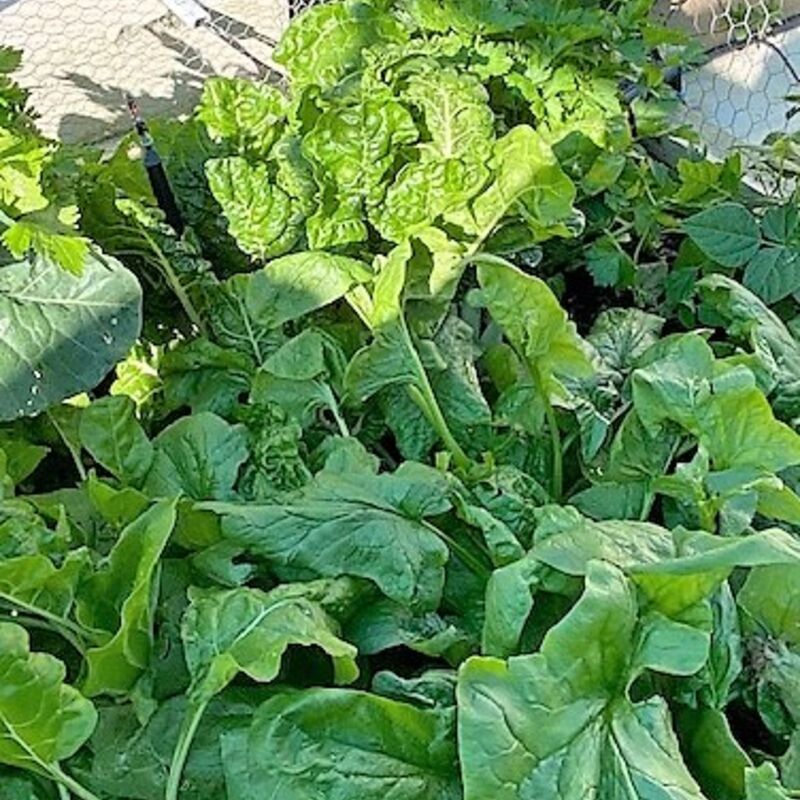Spinach

Spinach (Spinacia oleracea) is a leafy green flowering low growing annual plant native to central and western Asia.
Appearance
It may grow as tall as 30 cm (1 ft) with leaves that are alternate, simple, ovate to triangular, and very variable in size: from 1–12 in long and .4–6 broad, with larger leaves at the base of the plant and small leaves higher on the flowering stem.
The flowers are inconspicuous, yellow-green, 0.1–0.2 inches in diameter, and mature into a small, hard, dry, lumpy fruit cluster containing several seeds.
History
Ancient
Spinach originally came from Persia (now Iran), and then the green, leafy vegetable made its way to China in the 7th century, when the king of Nepal sent it as a gift, and was eventually brought to Europe in the 11th century when it was introduced to Spain by the Moors (Muslims).
Spinach is thought to have originated about 2000 years ago in ancient Persia, from which it was introduced to India and ancient China in 647 AD.
Spinach became a popular vegetable in the Arab Mediterranean and arrived in Spain by the 12th century.
Spinach first appeared in England and France in the 14th century, probably via Spain, and gained everyday use because it appeared in early spring when fresh local vegetables were unavailable.
Spinach was known as “the Spanish vegetable” in England.
In the 16th century, spinach became the favourite vegetable of Catherine de Medici of the famous Medici family of the Italian Renaissance. When she left her home in Florence, Italy, to marry King Henry II of France, she brought along her cooks who could prepare spinach in the many different ways that she liked. Since this time, dishes prepared on a bed of spinach are referred to as à la Florentine.
Recent
Spinach began being cultivated in North America by the early 19th century.
It has been popularized by the cartoon character Popeye, who attributes his extraordinary strength to a daily diet of green, leafy vegetables. When Popeye made his debut on January 17, 1929, spinach became the third most popular vegetable.
According to USDA’s Economic Research Service figures, annual consumption of all kinds of spinach (fresh, frozen and canned) jumped 66 per cent in the decade between 1992 and 2002, primarily due to the availability of pre-cut, bagged spinach.
In 2018, world spinach production was 26.3 million tonnes, with China alone accounting for 90% of the total.
Varieties grown:
1. Savoy spinach:
Savoy spinach is more productive than the other two forms of spinach. It also handles the cold better than the different varieties. As for appearance, it has very crinkled leaves that grow pretty low, which means that you have to bend down a bit to clean the leaves.
Example: Bloomsdale: Thick-leafed spinach, somewhat succulent and savoury, and produces ample yields during the early part of the summer
2. Semi-savoy spinach:
A variety grows more upright than savoy spinach; its leaves are much less wrinkled and are disease and bolt resistant.
Example: Indian Summer: productive, three-season spinach for production in spring, summer and fall. Its leaves are flattened and relatively smooth.
3. Smooth-leafed Spinach:
The leaf has a smooth surface that is the easiest to clean, frequently canned and frozen variety, but sold fresh as well.
Example – space spinach which is slow to bolt
Culinary
Its leaves are a common edible vegetable consumed either fresh or after storage using preservation techniques by canning, freezing or dehydration.
It may be eaten cooked or raw, and the taste differs considerably; the high oxalate content may be reduced by steaming.
Fresh spinach loses much of its nutritional value with storage of more than a few days. While refrigeration slows this effect to about eight days, fresh spinach loses most of its folate and carotenoid content over this period.
For more extended storage, it is canned or blanched or cooked and frozen. Cooked spinach has a spicy, earthy flavour and a mushy texture; raw spinach is milder and crisp.
Raw spinach is 91% water, 4% carbohydrates, 3% protein, and little fat.
Spinach has a high nutritional value, especially when fresh, frozen, steamed, or quickly boiled. It is a rich source (20% or more of the daily value, DV) of vitamins A, C and K, magnesium, manganese and folate.
Spinach is a good source (10-19% of DV) of the B vitamins riboflavin and B6, vitamin E, calcium potassium and dietary fibre.
Although spinach is touted as high in iron and calcium content and is often served and consumed in its raw form, raw spinach contains high levels of oxalates, which block absorption of calcium and iron in the stomach and small intestine.
Spinach cooked in several water changes has much lower levels of oxalates and is better digested, and its nutrients are absorbed more completely.
Medical
Vitamin K
A quantity of 100 g of spinach contains over four times the recommended daily intake of vitamin K.
Hence, individuals taking the anticoagulant warfarin, which inhibits vitamin K –should minimize consumption of spinach, and other dark green leafy vegetables, to avoid blunting the effect of warfarin.
Growth
Pollination
pests
Harvesting
